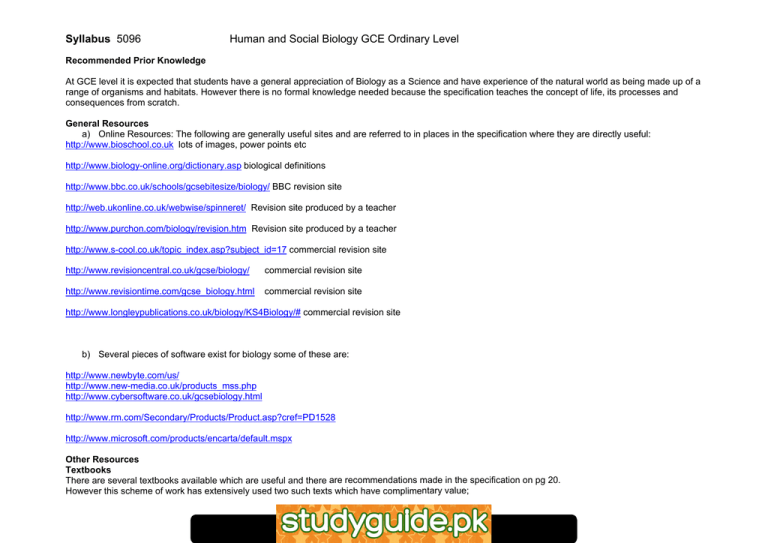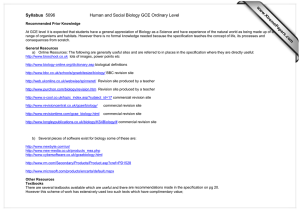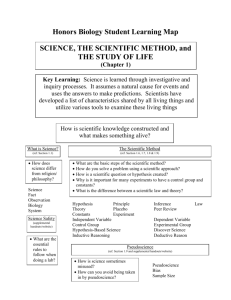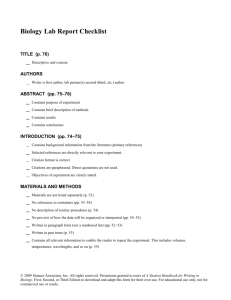Syllabus Human and Social Biology GCE Ordinary Level
advertisement

Syllabus 5096 Human and Social Biology GCE Ordinary Level Recommended Prior Knowledge At GCE level it is expected that students have a general appreciation of Biology as a Science and have experience of the natural world as being made up of a range of organisms and habitats. However there is no formal knowledge needed because the specification teaches the concept of life, its processes and consequences from scratch. General Resources a) Online Resources: The following are generally useful sites and are referred to in places in the specification where they are directly useful: http://www.bioschool.co.uk lots of images, power points etc http://www.biology-online.org/dictionary.asp biological definitions http://www.bbc.co.uk/schools/gcsebitesize/biology/ BBC revision site http://web.ukonline.co.uk/webwise/spinneret/ Revision site produced by a teacher http://www.purchon.com/biology/revision.htm Revision site produced by a teacher http://www.s-cool.co.uk/topic_index.asp?subject_id=17 commercial revision site http://www.revisioncentral.co.uk/gcse/biology/ commercial revision site http://www.revisiontime.com/gcse_biology.html commercial revision site http://www.longleypublications.co.uk/biology/KS4Biology/# commercial revision site b) Several pieces of software exist for biology some of these are: http://www.newbyte.com/us/ http://www.new-media.co.uk/products_mss.php http://www.cybersoftware.co.uk/gcsebiology.html http://www.rm.com/Secondary/Products/Product.asp?cref=PD1528 http://www.microsoft.com/products/encarta/default.mspx Other Resources Textbooks There are several textbooks available which are useful and there are recommendations made in the specification on pg 20. However this scheme of work has extensively used two such texts which have complimentary value; www.xtremepapers.net • D.G Mackean (1987) “Introduction to Human and Social Biology” Second Edition ISBN 0 71 954167 0 This is a very popular text and possibly possessed by many Centres, it is very detailed and has more than enough content for the specification. • P. Gadd (1993) “Human and Social Biology for the Tropics” fourth Edition ISBN 0 33 355280 6 This is a newer book and it has a much simpler format than Mackean, its content has been specifically selected to “meet the requirements of the syllabus of the Cambridge Local Examination Syndicate in Human and Social Biology at GCE O Level” It lives up to this claim admirably and gives students the basic knowledge for this specification. Wherever possible both text’s references have been used. There is no intention to indicate that other texts are unsuitable and if centres do possess other books the relevant material will need to be found in those. Videos “You are what you eat” “Suckers” Project Icarus Ltd “The Living Body” BBC production “Human Body” Robert Winston Double Video (http://www.amazon.co.uk/exec/obidos/ASIN/B00004CWQH/ref=ase_wwwlink-software-21/026-7871079-1955632 ) UNITS Suggested unit pairs A (19%) Unit (with Approx time allocation) 1 (11%) 2 (8%) Specification titles Outline of topic content Syllabus references Characteristics of Living Organisms 8% Define characteristics of life and of viruses, bacteria, fungi, protozoa, flatworms and insects. Describing animal and plant cells. Investigating Osmosis and Diffusion. Define Active transport Define tissues and organs 1a,b,c,d,e,f,g,h,I,j,k,l,m. Plants, Food and Humans 3% Describing photosynthesis and its role in the Carbon cycle. The Nitrogen cycle 2a,b,c,d,e. Nutrition and Diet 8% Sources and Uses of the major nutrients. Practical tests for Carbohydrates, Proteins and Fats. Sources and functions of vitamins (A,C and D) and 3a,b,c,d,e,f,g,h,I,j,k,l,m,o www.xtremepapers.net minerals (Ca and Fe) and their preservation in cooking Uses of water and the function of Fibre Balanced Diet and changes with Age, pregnancy and breastfeeding. Malnutrition and breast feeding. B (19%) C (19%) 3 (11%) Digestion and Absorption of Food 11% 4 (8%) Blood and the Circulatory System 8% 5 (8%) Breathing and Respiration 8% 6 (11%) Skeleton, Muscle and Movement 5% Physical digestion and tooth structure. Structure of the Alimentary Canal. Enzyme activity and temp. and pH. Sites of digestive enzymes and their functions. Water absorption and the Colon. Egestion Blood cells and plasma structure and function. Clotting and platelets. Structure of the Heart. The pacemaker and heart problems. Blood vessels structure and function. Lymph and tissue fluid. Breathing process and the role of pressure and volume changes, mouth to mouth resuscitation. Vital capacity and change in breathing rate. Role of respiration in production of energy and energy requiring activities. Cigarettes and effect on health of the smoker and a foetus Structure of the various materials in the skeletal system. Movement of joints. The arm and movement showing 4a,b,c,d,e,f,g,h,I,j,k,l,m,n,o,p,q. 7k 5a,b,c,d,e,f,g,h,I,j,k,l,m,n,o. 6a,b,c,d,e,f,g,h,I,j,k,l,m,n,o,p,q. 7a,b,c,d,e,f,g,h,I,j ref to 7k taught in units 3 and 7 www.xtremepapers.net Antagonistic muscle action. Ref to peristalsis and the eye muscles Homeostasis 6% D (19%) 8a,b,c,d,e,f,g,h,I,j,k,l,m,n,o. Structure of the kidney and its role in excretion and water control. Sweating and water loss, skin structure and loss of heat, control of body temp. Control of sugar in the blood, function of insulin and glucagon and the role of the pancreas and the liver 7 (8%) The Senses, Nervous System, Hormones and Coordination 8% Stimuli reception and reflexes. Structure and functioning of the eye in focusing and image formation. Hormone functioning ref to reproduction in unit 8 and insulin in unit 6. Comparing nervous and hormonal responses. Drug dependence and alcohol and heroin effects. 9a,b,c,d,e,f,g,h,I,j,k,l,m,n,o,r,s,t,u ,v. ref to 10e,f and 8m,n,o. covered in Units 8 and 6 8 (11%) Reproduction and the Continuity of life 11% Male and female reproductive systems. The menstrual cycle and the role of hormones. (ref to 9p Sexual reproduction and development of foetus, role of the placenta and amnion Birth. Genes, DNA, alleles and chromosomes and ribosome function. Mitosis and meiosis functions. Genetic symbols and monohybrid cross and inheritance of sex. 10a,b,c,d,e,f,g,h,I,j,k,l,m,n,o,p,q, r,s,t,u. ref to 9p www.xtremepapers.net E (21%) 9 (11%) 10 (10%) Health and Disease 8% Definition of types of diseases. Distinction between signs and symptoms. Signs, pathogens, transmission and control of 9 specified illnesses. 11a,b,c,d,e,f,g,h,I,j,k,l,m,n,o Ref to 12a,b,j,f,k. Control of Disease 3% Define antibiotics and ref to gonorrhoea. Distinguish between Antiseptics and disinfectants, investigate disinfectants and bacterial growth. Life cycles of Housefly and Anopheles mosquito. Ref to control methods used in the diseases studied above. Define; immunity, active, passive, natural and artificial immunity. Discussion of WHO and smallpox and TB 12g,h,i,k. ref to 12a,b,c,d,e,f,j. taught in 11h,i,k,l,m,n, Sewage and the pit latrine ref to Unit 9 and control of illnesses. Treatment of sewage. Treatment of water. Problems of waste disposal and the various methods possible 14a,b,c,d,e,f,g,h,I, Motor fumes and Carbon monoxide, lead and nitrogen oxides. Effect of Lead on body Sewage, chemical waste run-off and oil pollution. 15a,b,c,d Immunity and Immunisation 2% Community Health 5% Pollution 3% 13a,b,c,d,e. and ref to 11l 14j,k,l,m. ref to 12k and 11k TEACHING ORDER Although there is no definitive order to the teaching of the various topics there are some general points that make the teaching more efficient • Topics are of varying sizes with reference to content so have been grouped together to make 5 roughly equal amounts, if they were taught in a different combination they may not maintain this equality. • Characteristics of Living organisms underpins the rest of the Specification and so is an obligatory first topic www.xtremepapers.net • • • Health and Disease and Control of Disease cross reference to each other and so would be more efficiently taught together Community Health is covered in the above and so should follow them Some units do refer to earlier work and if a different order was adopted then this would have to be borne in mind if it was a problem www.xtremepapers.net




